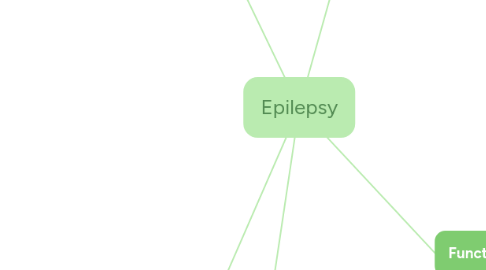
1. Pathophysiology
1.1. Cause
1.1.1. No general identifiable cause
1.1.2. Genetics
1.1.2.1. Certain genes linked to having epilepsy
1.1.2.2. Certain genes linked to making pt more sensitive to some environmental conditions that trigger seizures
1.1.3. Head trauma
1.1.3.1. Serious trauma such as car accident or other blow to the head can injure the brain and cause seizures
1.1.4. Stroke
1.1.4.1. Leading cause of development of epilepsy in adults over the age of 35
1.1.4.2. Tumor
1.1.5. Infectious disease
1.1.5.1. Meningitis
1.1.5.2. AIDS
1.1.5.3. Viral encephalitis
1.1.6. Prenatal injury
1.1.6.1. Damage to the brain in utero such as the mother having an infection, poor nutrition, etc can cause epilepsy in fetus
1.1.6.2. Some seizures occur when children come down with high fever, but this does not necessarily produce diagnosis of epilepsy
2. Assessment
2.1. Neurological focused assessment with subjective and objective portions
2.1.1. Subjective
2.1.1.1. Questions about lifestyle, health perception, personal history, family history, possible risk factors
2.1.2. Objective
2.1.2.1. Test behavior, motor function, mental function to create diagnosis and determine type/cause of epilepsy
2.1.2.2. Blood tests to check for infection or genetic conditions that may cause onset of epilepsy
2.1.2.3. Imaging
2.1.2.3.1. EEG: record electrical activity of brain, areas affected
2.1.2.3.2. CT: Detect tumors, bleeds, cysts that cause seizures
2.1.2.3.3. MRI: lesions and abnormalities; FMRI: measure changes in blood flow
2.1.2.3.4. Curry analysis
3. Complications
3.1. Psychosocial
3.1.1. Loss of independence
3.1.2. Unemployment
3.1.3. Decreased physical activity
3.2. Complications with treatment
3.2.1. Some epilepsy medications have negative side effects, such as severe mood swings, rashes, nausea, more seizures
3.2.2. Some medications cause birth defects if mother takes them during pregnancy
3.2.3. Some medications do not work for some pt at all, which may cause frustration and additional psychological issues
3.2.4. If surgery is done (remove corpus callosum), there is risk for damage
3.3. Pathological
3.3.1. Permanent brain damage
3.3.1.1. "Status epilepticus" is a seizure for more than 5 minutes, or several seizures in a row without regaining consciousness from the last one
3.3.1.1.1. The impaired function and trauma poses risk for permanent damage, though rare
3.3.2. SUDEP (sudden unexplained death in epilepsy)
3.3.2.1. May be related to heart and respiratory complications from epilepsy
4. System
4.1. Neurological
5. Functional Health Patterns
5.1. Health perception/health management
5.1.1. Risk for fall
5.1.2. Risk for injury
5.1.3. Risk for suffocation
5.1.4. Risk for trauma
5.2. Elimination
5.2.1. Stress urinary incontinence
5.3. Activity-exercise
5.3.1. Fatigue
5.3.2. Ineffective airway clearance
5.3.3. Risk for activity intolerance
5.3.4. Wandering
5.4. Sleep-rest
5.4.1. Disturbed sleep pattern
5.4.2. Sleep deprivation
5.5. Cognitive-perceptual
5.5.1. Acute confusion
5.5.2. Disturbed sensory perception (visual, auditory, kinesthetic, gustatory, tactile, olfactory)
5.5.3. Impaired comfort
5.5.4. Impaired memory
5.6. Self-perception/self-concept
5.6.1. Anxiety
5.6.2. Chronic low self esteem
5.6.3. Disturbed body image
5.6.4. Fear
5.6.5. Hopelessness
5.6.6. Ineffective impulse control
5.6.7. Powerlessness
5.6.8. Readiness for enhanced hope
5.6.9. Readiness for enhanced self concept
5.6.10. Risk for loneliness
5.6.11. Risk for self directed violence
5.7. Role-relationship
5.7.1. Chronic sorrow
5.7.2. Impaired social interaction
5.7.3. Interrupted family processes
5.7.4. Social isolation
5.8. Coping-stress tolerance
5.8.1. Compromised family coping
5.8.2. Impaired mood regulation
5.8.3. Impaired resilience
5.8.4. Ineffective coping
5.8.5. Post-trauma syndrome
5.8.6. Readiness for enhanced coping/family coping
5.8.7. Stress overload
